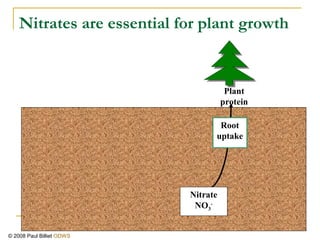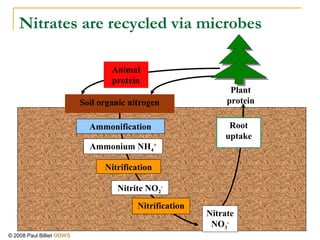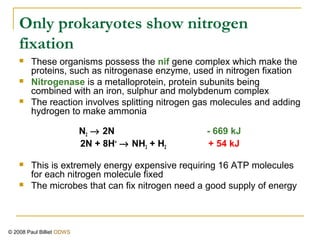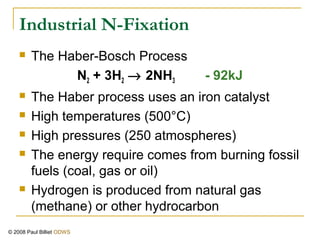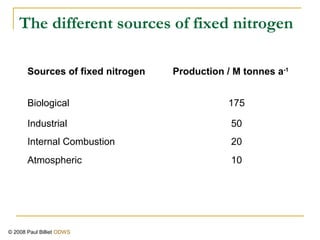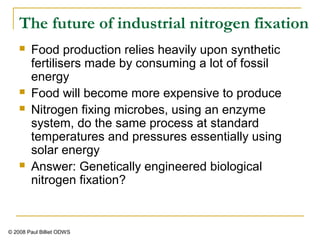Nitrogen cycle
- 2. Nitrates are essential for plant growth Root uptake Nitrate NO3 - Plant protein © 2008 Paul Billiet ODWS
- 3. Nitrates are recycled via microbes Nitrification Nitrification Ammonium NH4 + Ammonification Nitrite NO2 - Soil organic nitrogen Animal protein Root uptake Nitrate NO3 - Plant protein © 2008 Paul Billiet ODWS
- 4. Ammonification Nitrogen enters the soil through the decomposition of protein in dead organic matter Amino acids + 11 /2O2 → CO2 + H2O + NH3 + 736kJ This process liberates a lot of energy which can be used by the saprotrophic microbes © 2008 Paul Billiet ODWS
- 5. Nitrification This involves two oxidation processes The ammonia produced by ammonification is an energy rich substrate for Nitrosomas bacteria They oxidise it to nitrite: NH3 + 11 /2O2 → NO2 - + H2O + 276kJ This in turn provides a substrate for Nitrobacter bacteria oxidise the nitrite to nitrate: NO3 - + 1 /2O2 → NO3 - + 73 kJ This energy is the only source of energy for these prokaryotes They are chemoautotrophs © 2008 Paul Billiet ODWS
- 6. Root uptake Nitrate NO3 - Plant protein Soil organic nitrogen Nitrogen from the atmosphere Biological fixation Atmospheric fixationOut gassin g Atmospheric Nitrogen 4 000 000 000 Gt © 2008 Paul Billiet ODWS
- 7. Atmospheric nitrogen fixation Electrical storms Lightning provides sufficient energy to split the nitrogen atoms of nitrogen gas, Forming oxides of nitrogen NOx and NO2 © 2008 Paul Billiet ODWS
- 8. Atmospheric Pollution This also happens inside the internal combustion engines of cars The exhaust emissions of cars contribute a lot to atmospheric pollution in the form of NOx These compounds form photochemical smogs They are green house gases They dissolve in rain to contribute to acid rain in the form of nitric acid The rain falling on soil and running into rivers They contribute to the eutrophication of water bodies © 2008 Paul Billiet ODWS
- 9. Biological nitrogen fixation Treatments Yield / g Oats Peas No nitrate & sterile soil 0.6 0.8 Nitrate added & sterile soil 12.0 12.9 No nitrate & non-sterile soil 0.7 16.4 Nitrate added & non-sterile soil 11.6 15.3 © 2008 Paul Billiet ODWS
- 10. Conclusion Adding nitrate fertiliser clearly helps the growth of both plants The presence of microbes permits the peas to grow much better than the oats The peas grow better in the presence of the microbes than they do with nitrate fertiliser added The difference is due to the present of mutualistic nitrogen fixing bacteria which live in the pea roots. © 2008 Paul Billiet ODWS
- 11. University of Sydney Alafalfa (Medicago sativa) USDA - ARS Root nodules
- 12. Only prokaryotes show nitrogen fixation These organisms possess the nif gene complex which make the proteins, such as nitrogenase enzyme, used in nitrogen fixation Nitrogenase is a metalloprotein, protein subunits being combined with an iron, sulphur and molybdenum complex The reaction involves splitting nitrogen gas molecules and adding hydrogen to make ammonia N2 → 2N - 669 kJ 2N + 8H+ → NH3 + H2 + 54 kJ This is extremely energy expensive requiring 16 ATP molecules for each nitrogen molecule fixed The microbes that can fix nitrogen need a good supply of energy © 2008 Paul Billiet ODWS
- 13. The nitrogen fixers Cyanobacteria are nitrogen fixers that also fix carbon (these are photosynthetic) Rhizobium bacteria are mutualistic with certain plant species e.g. Legumes They grow in root nodules Azotobacter are bacteria associated with the rooting zone (the rhizosphere) of plants in grasslands © 2008 Paul Billiet ODWS
- 14. Nitrate NO3 - Atmospheric fixation Out gassin g Plant protein Atmospheric Nitrogen Ammonium NH4 + Soil organic nitrogen The human impact Biological fixation Industrial fixation © 2008 Paul Billiet ODWS
- 15. Industrial N-Fixation The Haber-Bosch Process N2 + 3H2 → 2NH3 - 92kJ The Haber process uses an iron catalyst High temperatures (500°C) High pressures (250 atmospheres) The energy require comes from burning fossil fuels (coal, gas or oil) Hydrogen is produced from natural gas (methane) or other hydrocarbon © 2008 Paul Billiet ODWS
- 16. The different sources of fixed nitrogen Sources of fixed nitrogen Production / M tonnes a-1 Biological 175 Industrial 50 Internal Combustion 20 Atmospheric 10 © 2008 Paul Billiet ODWS
- 17. Eutrophication Nutrient enrichment of water bodies Nitrates and ammonia are very soluble in water They are easily washed (leached) from free draining soils These soils tend to be deficient in nitrogen When fertiliser is added to these soils it too will be washed out into water bodies There algae benefit from the extra nitrogen This leads to a serious form of water pollution © 2008 Paul Billiet ODWS
- 18. Fertilisers washed into river or lake New limiting factor imposes itselfSewage or other organic waste Eutrophication © 2008 Paul Billiet ODWS
- 19. Increased Biochemical Oxygen Demand (BOD) Hot water from industry (Thermal pollution) Pollution from oil or detergents Reduction in dissolved O2 Making things worse! © 2008 Paul Billiet ODWS
- 20. The death of a lake Death/emigration of freshwater fauna Methaemoglobinaemia in infants Stomach cancer link (WHO limit for nitrates 10mg dm-3 ) Increased nitrite levels NO3 - → NO2 - Reduction in dissolved O2 © 2008 Paul Billiet ODWS
- 21. The future of industrial nitrogen fixation Food production relies heavily upon synthetic fertilisers made by consuming a lot of fossil energy Food will become more expensive to produce Nitrogen fixing microbes, using an enzyme system, do the same process at standard temperatures and pressures essentially using solar energy Answer: Genetically engineered biological nitrogen fixation? © 2008 Paul Billiet ODWS
- 22. Making things better The need for synthetic fertilisers can be reduced by cultural practices Avoiding the use of soluble fertilisers in sandy (free draining soil) prevents leaching Rotating crops permits the soil to recover from nitrogen hungry crops (e.g. wheat) Adding a nitrogen fixing crop into the rotation cycle Ploughing aerates the soil and reduces denitrification Draining water logged soil also helps reduce denitrification © 2008 Paul Billiet ODWS
- 23. Return to the atmosphere: Denitrification Nitrates and nitrites can be used a source of oxygen for Pseudomonas bacteria Favourable conditions: Cold waterlogged (anaerobic) soils 2NO3 - → 3O2 + N2↑providing up to 2385kJ 2NO2 - → 2O2 + N2 ↑ The liberated oxygen is used as an electron acceptor in the processes that oxidise organic molecules, such as glucose These microbes are, therefore, heterotrophs © 2008 Paul Billiet ODWS
- 24. Sediments 10 Gt Nitrification Root uptake Biological fixation Nitrification Ammonium NH4 + Ammonification Nitrite NO2 - Dissolved in water 6000 Gt Denitrification Leaching Nitrate NO3 - Soil organic nitrogen 9500 Gt Atmospheric fixation Out gassin g Industrial fixation Plant protein 3500 Gt Animal protein Atmospheric Nitrogen 4 000 000 000 Gt © 2008 Paul Billiet ODWS

